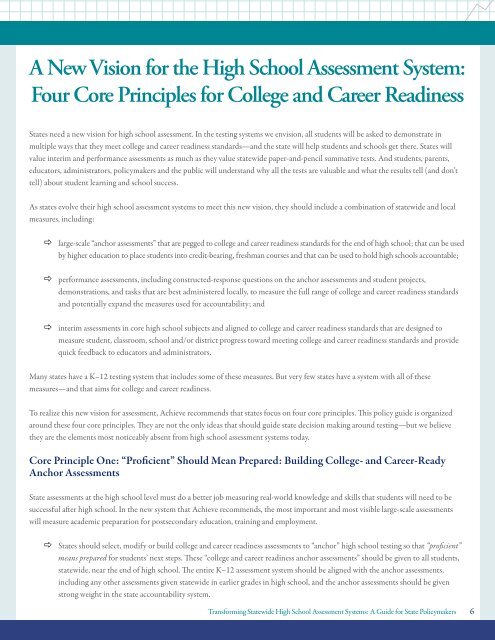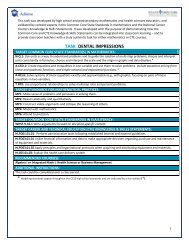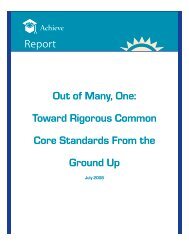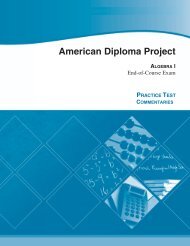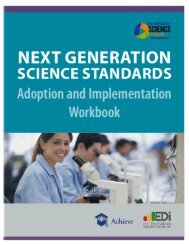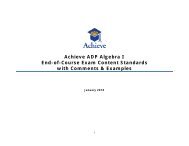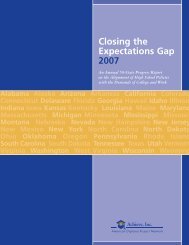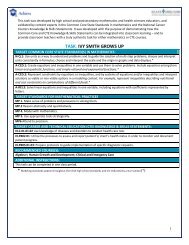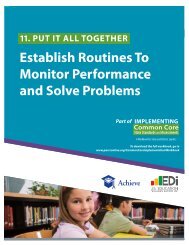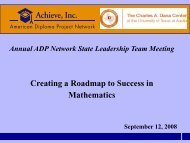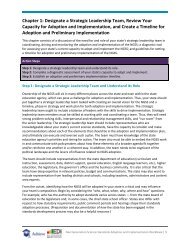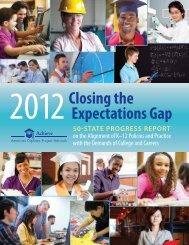Transforming Statewide High School Assessment Systems: - Achieve
Transforming Statewide High School Assessment Systems: - Achieve
Transforming Statewide High School Assessment Systems: - Achieve
You also want an ePaper? Increase the reach of your titles
YUMPU automatically turns print PDFs into web optimized ePapers that Google loves.
A New Vision for the <strong>High</strong> <strong>School</strong> <strong>Assessment</strong> System:Four Core Principles for College and Career ReadinessStates need a new vision for high school assessment. In the testing systems we envision, all students will be asked to demonstrate inmultiple ways that they meet college and career readiness standards—and the state will help students and schools get there. States willvalue interim and performance assessments as much as they value statewide paper-and-pencil summative tests. And students, parents,educators, administrators, policymakers and the public will understand why all the tests are valuable and what the results tell (and don’ttell) about student learning and school success.As states evolve their high school assessment systems to meet this new vision, they should include a combination of statewide and localmeasures, including:large-scale “anchor assessments” that are pegged to college and career readiness standards for the end of high school; that can be usedby higher education to place students into credit-bearing, freshman courses and that can be used to hold high schools accountable;performance assessments, including constructed-response questions on the anchor assessments and student projects,demonstrations, and tasks that are best administered locally, to measure the full range of college and career readiness standardsand potentially expand the measures used for accountability; andinterim assessments in core high school subjects and aligned to college and career readiness standards that are designed tomeasure student, classroom, school and/or district progress toward meeting college and career readiness standards and providequick feedback to educators and administrators.Many states have a K–12 testing system that includes some of these measures. But very few states have a system with all of thesemeasures—and that aims for college and career readiness.To realize this new vision for assessment, <strong>Achieve</strong> recommends that states focus on four core principles. This policy guide is organizedaround these four core principles. They are not the only ideas that should guide state decision making around testing—but we believethey are the elements most noticeably absent from high school assessment systems today.Core Principle One: “Proficient” Should Mean Prepared: Building College- and Career-ReadyAnchor <strong>Assessment</strong>sState assessments at the high school level must do a better job measuring real-world knowledge and skills that students will need to besuccessful after high school. In the new system that <strong>Achieve</strong> recommends, the most important and most visible large-scale assessmentswill measure academic preparation for postsecondary education, training and employment.States should select, modify or build college and career readiness assessments to “anchor” high school testing so that “proficient”means prepared for students’ next steps. These “college and career readiness anchor assessments” should be given to all students,statewide, near the end of high school. The entire K–12 assessment system should be aligned with the anchor assessments,including any other assessments given statewide in earlier grades in high school, and the anchor assessments should be givenstrong weight in the state accountability system.<strong>Transforming</strong> <strong>Statewide</strong> <strong>High</strong> <strong>School</strong> <strong>Assessment</strong> <strong>Systems</strong>: A Guide for State Policymakers 6


